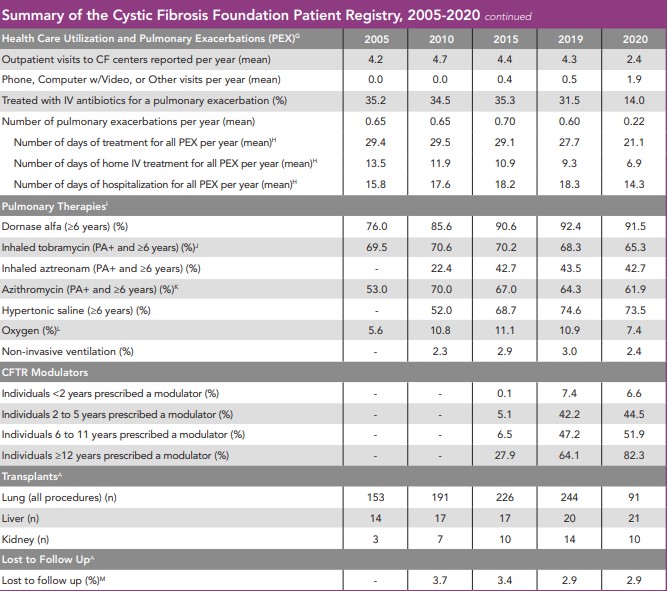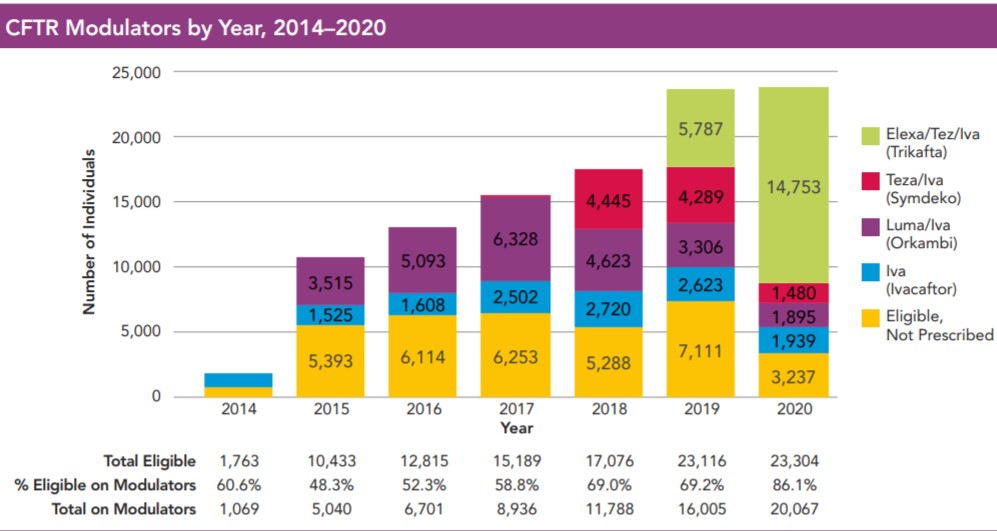Last week we celebrated news out of the North American Cystic Fibrosis Conference that median age of survival (remember, the age beyond which we expect 50% of people with CF born today to live, under the assumption that recent age-specific mortality rates will hold for the rest of their lives) climbed to 50 years old, but this week the news keeps getting (mostly) better.
The 2020 Cystic Fibrosis Foundation Patient Registry was published and a quick look at the data tell me that Trikala couldn’t have been approved at a better time for our community – literally right before the pandemic – and the data speak for themselves.

The gold statistic for declining CF health in terms of healthcare utilization – “treated with IV antibiotics for a pulmonary exacerbation” – dropped by over 50% from 2019 to 2020. The registry shows that only 14% of all patients tracked by the registry required IV antibiotics. That number has been slowly decreasing over the years as more and more people gained access to highly effective modulator therapy, but because only a finite number of people could benefit from early generations the aggregate benefit wasn’t felt community wide.
Of course, it must be admitted that the pandemic and hospital capacity variation could have also contributed to this decline, and definitely confound a lot of the data in the registry, but I certainly don’t think that it could explain the entire decline.
Also remarkable is the number of people who required lung transplant in 2020. Seeing that number drop by 60% pays dividends not only to the CF community, but also the broader US healthcare system wherein lungs available for transplant are an extremely scarce resource. On an absolute scale, though, 91 people requiring transplant because of cystic fibrosis in 2020 suggests that the fight against the disease isn’t over yet. There are still people in our population who have severe disease and will eventually require transplantation earlier than we all would hope for them.
And that’s why I said above that the news is mostly better. Last week I pointed out that I wouldn’t expect to see the median age of death climb quite as quickly as median survival. Median age of death represents the halfway point in age for all the people with CF who passed away in a specific year (2020 in this case), which was 34.1 last year. Compared to the 2019 median age of death, 32.4, 2020’s gain is important but not quite as large as I would have hoped.
That number represents something that I’d hope we can all agree on, and it’s that too many people are dying too young from cystic fibrosis. That number is still going to be a little troubling over the coming several years (as a commenter on my last blog pointed out) because of some of the complications that come along with transplant and the lag time for the small part of our population that is not yet able to benefit from a disease modifying medication.
Importantly, though, the number of people with CF who passed away in 2020 (which is something median age of death can’t represent), dropped by over a third from 377 to 252. That in and of itself is remarkable, especially when you consider that we have all been living through the worst global health crisis in a generation. If there’s something in there to hope for, for the non-modulated population, it’s that standard of care is always improving!
These benefits are the kinds of things that people on Trikfata will probably tell you they would have imagined coming down the pipeline in future registry data, but it is remarkable to actually see it.
Further commentary on Trikfata because that’s such a big part of this:
- These data do not reflect expanded access for children because the label was expanded in 2021. Registry data lacks a full year.
- Access to modulators for the eligible population is extremely high. When you look at market penetration for drugs outside cystic fibrosis, you’d be very hard pressed to find something greater than 50% penetration, let alone close to 90%. That’s remarkable unto itself, and points to the respect that our payors have for the benefits of this class of drugs. (Remember, they will benefit even more as the CFTR modulator class of drugs cycles to generic!).
- In past conversations with some of the people associated with the registry, it was suggested to me that it will take a few years for the survival curves and data to accurately capture the full impact of Trikfata, but as a doctor told me over the summer: we’re learning how to treat cystic fibrosis all over again.

All in, my takeaway from this year’s registry data (especially health utilization) is that lower hospitalization and less time on supportive IV care means LESS disruption to life. That’s what this is all about and it is truly amazing.
The less time you, me, and our friends with CF spend inside hospital systems, the better it is for all of us.




